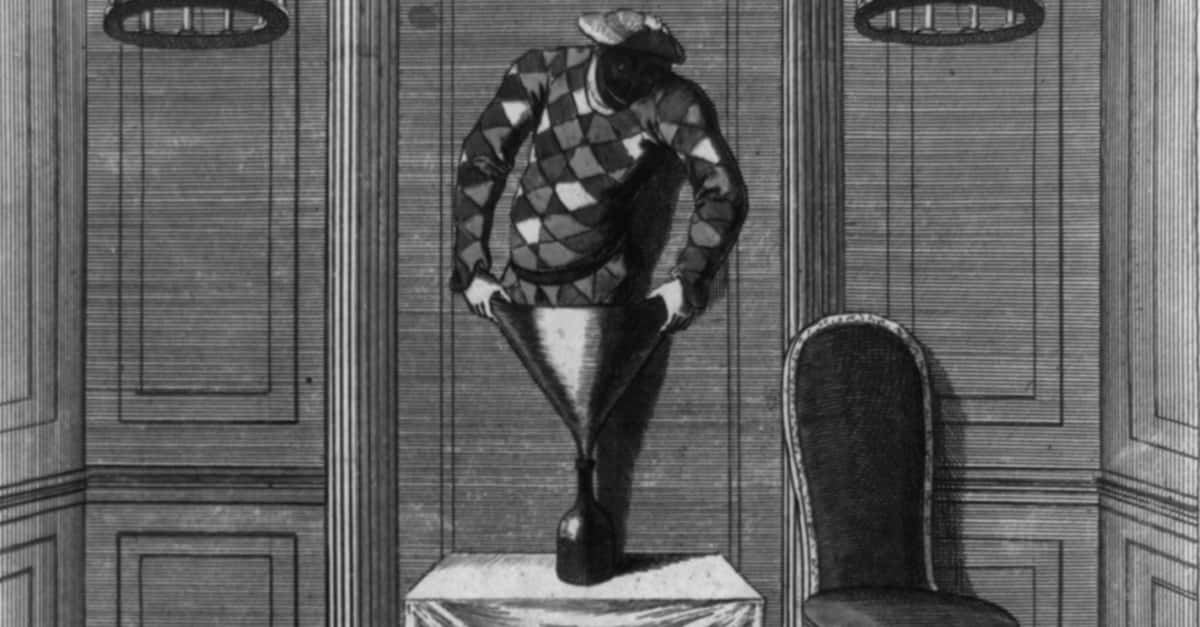Come One, Come All
On the evening of January 16, 1749, at around 7:00 pm, an expectant and excited crowd gathered at the Haymarket Theatre in London, England. They had a right to be eager: That night, an acrobat was due to miraculously fold himself into the confining space of an empty wine bottle. It was such a draw that even the king’s second son, the Duke of Cumberland, was in attendance.
Everyone found their seats and settled in—except the performer was late. First, people dismissed it as a delay. Eventually, they grew bored and restless. Then, a nervous theatre employee appeared from behind the curtain. He assured the audience that in the unlikely event the acrobat had skipped out, they would all get their money back. Finally, the crowd had to admit the embarrassing truth: Someone had played them. There was no man, there was no bottle, there was no miracle. It was all a hoax. That’s when the anger came.
Rage Quit
After the audience discovered that the contortionist’s feat was actually a disappearing act, all bets were off. Some members, the king’s son among them, quietly exited the building and nursed their disappointment. Others weren’t so mature. Soon, the stragglers attacked the theatre with the particular kind of rage that only bubbles up with guilt and shame. By the time the night was over, they nearly gutted the Haymarket’s insides.
In 2020, just after the Year of the Scam, the general consensus is to view this 18th-century indignation as a quaint, naïve response to an already-obvious hoax; critic Barbara M. Benedict wrote that the scam "made the audience fools of their own desire." I mean, c’mon guys, a man was going to pour himself into a wine bottle? We cynics, who live in an era of Instagram influencer sponcon promising us flat tummies without work and disease immunity without vaccines, don’t even have the luxury of outrage.
But, like most efforts to simplify the past to our benefit, I think this reading of the “Bottle Conjuror” is a mistake.
An Uncanny Hoax
If we only see the Haymarket crowd as easy marks and bumpkins, we miss something crucial. They weren’t necessarily upset that a man couldn’t really contort himself into a bottle. They were angry that he never even tried. Never mind that the wine bottle trick wasn’t the only feat the phantom performer was selling. An advance advertisement also claimed he could play multiple instruments on a cane, sing “to surprising perfection,” and identify anyone in the crowd by name.
Yet with no show to be had, the scam didn’t even attempt to deliver on its promises. This, I would argue, was the real problem. When we go to a magic show today, we aren’t scandalized to find out that a magician has tricks; we are happy enough to see the tricks and pretend they are real. This contract—what the poet Samuel Taylor Coleridge called a “suspension of disbelief”—is essential to any fiction we engage with. It’s a potentially beneficial placebo, one that allows us to become canny dupes in exchange for experiences that can be more expansive, exciting, and in some cases truer than strict reality. There is an art to how you deceive someone; in fact, that’s art.
Which isn’t to say that the wine bottle hoax, or any hoax, is a work of genius. If I buy some tummy tea and find out four weeks later that I haven’t lost 20 pounds, I’m not going to feel gratified by its fiction—though, by Haymarket’s standards, I should be glad it arrived at my doorstep in the first place. The 1749 advertisement was selling possibility. It was selling a night wondering just how the performer made it seem real. The no-show was what deflated it into a common prank. All the same, even this frustrating hoax had one thing in common with art. In the aftermath, everyone was looking for the author.
The Half-Wit’s Wager
In the cold clear light of day, the crowds waded through their rage hangovers to lay blame for the hoax at the doorstep of the theatre’s manager, Samuel Foote. Foote, they reasoned, must have known it was a hoax from the start. Either that, or else the owner John Potter was in on it. Both men, however, denied any involvement, and Potter claimed he himself had been suspicious of the “strange man” who had approached him about the performance. The series of denials led to one question: Who was this mysterious third man?
There’s no real way of confirming it hundreds of years later, but some historians believe the culprit was Duke John Montagu. There’s some solid evidence behind the theory, too. The duke was also a notorious prankster; the middle-aged noble’s regular tricks included “classics” like squirting people with water and putting itchy powders in beds. His own mother-in-law acknowledged that “all his talents lie in things only natural in boys of fifteen years old.” Most damning of all? He reportedly made a bet that he could fill a theatre by advertising an acrobat who could “creep into a quart bottle.”
Like many solved mysteries, this revelation is its own anti-climax. That’s right, the man behind the curtain was nothing more than a frat-boy duke. Even worse, it tests modern notions about scammers and pranksters. Our own beloved scams, from the Fyre Festival to the strippers of Hustlers to German fraudster “heiress” Anna Delvey, tell narratives that apparently expose the idiocy of the rich, but really just imbue their class position with an exaggerated and comforting fragility. Meanwhile, people like Montagu continue to scam us.
The Greatest Hoax Ever Made
After that night, the British press published a series of scornful articles denouncing "English credulity." One article even satirically suggested that the contortionist didn’t come because he really did make good on his promise. After granting a private performance to a viewer, the witness reportedly “corked up the bottle, whipped it in his pocket, and made off." It is, after all, nice to imagine a world where people really can fold themselves into bottles.
A prankster duped the people who went to Haymarket that night in 1749, but the 18th-century public and press were no more or less canny than we are today. We too have narratives we want to believe in, as well as ones that fail us. Isn’t that worth a riot?
















